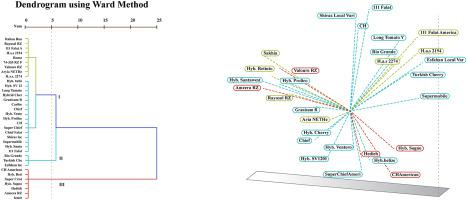当前位置:
X-MOL 学术
›
Phytochemistry
›
论文详情
Our official English website, www.x-mol.net, welcomes your
feedback! (Note: you will need to create a separate account there.)
Bio-genetic analysis of resistance in tomato to early blight disease, Alternaria alternata
Phytochemistry ( IF 3.2 ) Pub Date : 2020-11-01 , DOI: 10.1016/j.phytochem.2020.112486 Giti Alizadeh-Moghaddam 1 , Zahra Rezayatmand 1 , Mehdi Nasr- Esfahani 2 , Mahdi Khozaei 3
Phytochemistry ( IF 3.2 ) Pub Date : 2020-11-01 , DOI: 10.1016/j.phytochem.2020.112486 Giti Alizadeh-Moghaddam 1 , Zahra Rezayatmand 1 , Mehdi Nasr- Esfahani 2 , Mahdi Khozaei 3
Affiliation

|
Early blight disease (EB), Alternaria alternata, is destructive on Solanum lycopersicum Mill. The responses of 35 domestic and exotic commercial tomato genotypes to early blight were examined at transplanting and maturing stages using genetic diversity analysis, with 15 Inter Simple Sequence Repeat (ISSR) primers, total phenolic content (TPC), and enzymatic activity of catalase (CAT), phenylalanine ammonia lyase (PAL), peroxidase (POD) and superoxide dismutase (SOD) assays. The disease severity ranged from 18 to 87.5%. Eleven of 15 ISSR primers generated 68 loci of which 63 (90%) were polymorphic. Polymorphism information content value varied from 0.3 to 0.5 with an average of 0.4. Nei's measure of the average gene diversity ranged from 0.06 to 0.5. The Tomato genotypes were divided into five clusters in Un-weighted Pair Group Method with Arithmetic Mean (UPGMA) analysis, showing a considerable similarity between resistance level and molecular classification pattern. Antioxidant analysis indicated a significant increase in TPC and CAT, POD, PAL and SOD activities in most inoculated tomato genotypes at both growth stages. The highest increase in activity was seen in PAL (5-fold) and TPC (4-fold) at transplanting stage, whereas the highest TPC (2 to 3-fold) and POD activity (3-fold) were found at maturing stage in all the inoculated resistant genotypes in comparison with controls. Esfahan Local and H. a.s 2274 showed the highest level of activity in POD (2.5- and 3- fold, respectively) and TPC (2.5- and 4-fold, respectively). Our results suggest that using both genetic diversity and enzymatic diversity as markers, it is possible to discriminate resistant from susceptible tomato genotypes to early blight disease.
中文翻译:

番茄对早疫病、链格孢抗性的生物遗传分析
早疫病(EB),Alternaria alternata,对茄子具有破坏性。使用遗传多样性分析,利用 15 个内部简单序列重复 (ISSR) 引物、总酚含量 (TPC) 和过氧化氢酶的酶活性 (CAT),在移植和成熟阶段检查了 35 个国内外商业番茄基因型对早疫病的反应)、苯丙氨酸解氨酶 (PAL)、过氧化物酶 (POD) 和超氧化物歧化酶 (SOD) 检测。疾病的严重程度从 18% 到 87.5% 不等。15 个 ISSR 引物中的 11 个产生了 68 个基因座,其中 63 个 (90%) 是多态的。多态性信息含量值从0.3到0.5不等,平均为0.4。Nei 对平均基因多样性的测量范围为 0.06 到 0.5。番茄基因型在未加权对组法与算术平均值(UPGMA)分析中分为五个聚类,显示抗性水平和分子分类模式之间相当相似。抗氧化分析表明,大多数接种的番茄基因型在两个生长阶段的 TPC 和 CAT、POD、PAL 和 SOD 活性都显着增加。移栽阶段的 PAL(5 倍)和 TPC(4 倍)的活性增加最高,而在成熟阶段发现最高的 TPC(2 至 3 倍)和 POD 活性(3 倍)。与对照相比,所有接种的抗性基因型。Esfahan Local 和 H. as 2274 在 POD(分别为 2.5 倍和 3 倍)和 TPC(分别为 2.5 倍和 4 倍)中显示出最高水平的活性。
更新日期:2020-11-01
中文翻译:

番茄对早疫病、链格孢抗性的生物遗传分析
早疫病(EB),Alternaria alternata,对茄子具有破坏性。使用遗传多样性分析,利用 15 个内部简单序列重复 (ISSR) 引物、总酚含量 (TPC) 和过氧化氢酶的酶活性 (CAT),在移植和成熟阶段检查了 35 个国内外商业番茄基因型对早疫病的反应)、苯丙氨酸解氨酶 (PAL)、过氧化物酶 (POD) 和超氧化物歧化酶 (SOD) 检测。疾病的严重程度从 18% 到 87.5% 不等。15 个 ISSR 引物中的 11 个产生了 68 个基因座,其中 63 个 (90%) 是多态的。多态性信息含量值从0.3到0.5不等,平均为0.4。Nei 对平均基因多样性的测量范围为 0.06 到 0.5。番茄基因型在未加权对组法与算术平均值(UPGMA)分析中分为五个聚类,显示抗性水平和分子分类模式之间相当相似。抗氧化分析表明,大多数接种的番茄基因型在两个生长阶段的 TPC 和 CAT、POD、PAL 和 SOD 活性都显着增加。移栽阶段的 PAL(5 倍)和 TPC(4 倍)的活性增加最高,而在成熟阶段发现最高的 TPC(2 至 3 倍)和 POD 活性(3 倍)。与对照相比,所有接种的抗性基因型。Esfahan Local 和 H. as 2274 在 POD(分别为 2.5 倍和 3 倍)和 TPC(分别为 2.5 倍和 4 倍)中显示出最高水平的活性。









































 京公网安备 11010802027423号
京公网安备 11010802027423号